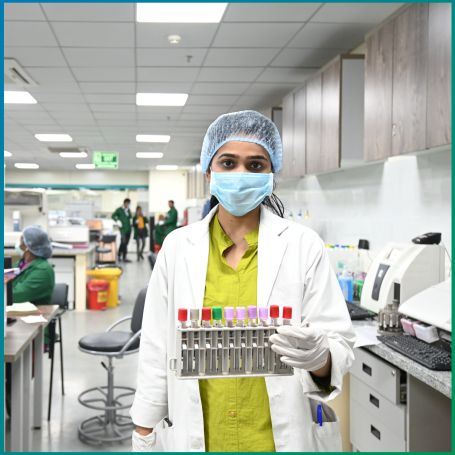
The Histopathology Small Test pune is an essential diagnostic tool used to examine small tissue samples for the presence of diseases, abnormalities, or malignancies.


This test involves the microscopic examination of tissues taken from the body to help doctors diagnose conditions ranging from infections to cancer. Histopathology, which refers to the study of tissues, plays a pivotal role in modern medicine, providing valuable insights into the nature of diseases, especially when imaging and clinical evaluation do not offer definitive answers.
The Histopathology Small Test is the microscopic examination of tissue samples that are generally small in size, such as those obtained from biopsies. The tissue is processed, sectioned, and stained to be evaluated under a microscope by a trained pathologist. This process allows for the identification of cellular changes that may indicate disease, abnormal growth, or the presence of cancer.
1] Tissue Collection: The first step of the Histopathology Small Test is the collection of tissue. This is generally done through a biopsy, where a small piece of tissue is removed from the affected organ or area. The biopsy may be performed using a needle (needle biopsy), punch biopsy, or excision biopsy depending on the location and suspected disease.
2] Fixation:Once collected, the tissue sample is placed in a fixative solution, typically formalin. This step preserves the tissue's structure and prevents decay, allowing it to be processed for microscopic examination.
3] Processing: The fixed tissue is then processed, which involves embedding it in paraffin wax. This makes the tissue easier to slice into thin sections, which can be placed on glass slides for further examination.
4] Staining: After the tissue is sectioned, it is stained using special dyes. Hematoxylin and eosin (H&E) are the most common stains used in histopathology, as they allow the pathologist to differentiate between various cellular structures and identify abnormalities.
5] Microscopic Examination: A pathologist then examines the stained slides under a microscope, looking for any signs of disease. The pathologist evaluates the cellular structure, tissue architecture, and any changes or abnormalities that might indicate the presence of disease.
The Histopathology Small Test results are provided after a microscopic examination of a small tissue sample. The pathologist analyzes the tissue to identify any abnormalities, infections, inflammation, or signs of diseases like cancer. Here’s what the possible results could indicate:
1. Normal Results:
A] Tissue Structure: The tissue sample appears normal under the microscope with no signs of abnormal growth or cellular changes.
B] Cellular Composition: The cells within the tissue have a normal appearance and structure, with no signs of disease, inflammation, or infection.
C] No Pathology Detected: There are no abnormalities, and the tissue sample shows typical, healthy features.
2. Abnormal Results:
A] Presence of Cancer: The sample may show signs of malignant (cancerous) growth, such as abnormal cell structure, rapid growth, or uncontrolled cell division. Based on this, the type and stage of cancer may be identified.
B] Inflammation or Infection: The tissue may show signs of infection or inflammation, which could be acute (sudden onset) or chronic (long-term). This might indicate bacterial, viral, or fungal infections or diseases like Crohn's disease or ulcerative colitis.
C] Benign Tumors: Sometimes, a tissue sample may indicate the presence of a benign (non-cancerous) tumor or growth, which may not spread but could still require treatment.
At Diagnopein, we pride ourselves on providing world-class diagnostic services, including the Histopathology Small Test pune. Our team consists of highly skilled and experienced pathologists who have years of experience in diagnosing a wide range of diseases. Their expertise ensures accurate and timely results. Our commitment to using the best technology ensures that we provide high-quality diagnostic services. We use cutting-edge technology and advanced laboratory equipment to process tissue samples.
We understand that timely results are essential for treatment planning. At Diagnopein, we ensure that the Histopathology Small Test results are delivered promptly without compromising accuracy. Diagnopein believes in providing high-quality healthcare at affordable prices. Our histopathology tests are priced competitively, ensuring that patients receive the best care without financial strain.
There’s typically no special preparation for the test itself, as it focuses on analyzing tissue already collected. However, if you’re undergoing a biopsy, your doctor may provide specific instructions, such as: Avoiding certain medications that could affect bleeding. Fasting before the procedure, depending on the biopsy type. Arranging for someone to drive you home if sedation or anesthesia is used.
The test itself involves analyzing a tissue sample, which is painless. However, the biopsy procedure to obtain the tissue sample might involve minor discomfort, depending on the type of biopsy. Local anesthesia is typically used to minimize pain during the biopsy.
There are no risks associated with the test itself. However, the biopsy procedure used to collect the tissue sample carries minor risks, such as Slight bleeding or bruising at the biopsy site, Infection & Temporary discomfort or swelling.
While the Histopathology Small Test is an essential tool for detecting many types of cancer, it may not detect all cancer types in a single test. Some cancers may require additional molecular testing or immunohistochemistry to identify specific markers and mutations.